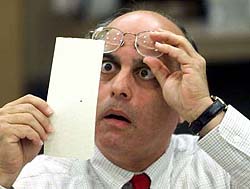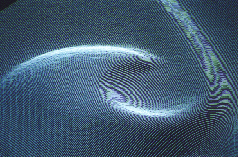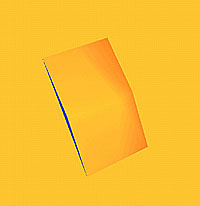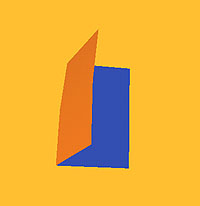
Digital Preservation of Florida's Undervotes-- A proposed project idea that, unfortunately, never received funding ---- provided for the curious and historically inclined reader -- This page provides background information on a proposed project that would create a three-dimensional dataset of Florida's so-called "undervotes" for future analyses by historians, political and social scientists, and other interested parties. These undervotes cast in the state of Florida during the presidential election 2000 are for the most part punch card ballots that showed "no vote for president" when subjected to a machine count. Manual inspection of these votes, however, revealed various forms of a voter's manipulation on some of these ballots in the form of displaced or deformed chads (known as hanging, dangling, indented, pregnant, or dimpled chads). More information describing the digital preservation of these undervotes can be found in the
The proposed process would scan all undervotes using laser scanning devices, create a three-dimensional representation of these questionable ballots, and make this dataset available on the Internet for inspection by any interested party.
Creating a 3D Representation A three-dimensional computer representation of a ballot can be created using various techniques including
When selecting scanning equipment for the proposed project, scanning area (volume), resolution, accuracy, portability of equipment, required scan time and other parameters need to be considered. To capture the geometry of a ballot's deformed chads, sub-millimeter resolution is required. 3D scanners create large amounts of data that need to be reduced, processed, and converted into usable formats. Some of the problems typically found in scanned 3D geometry are illustrated below.
An interesting, related link describes The Digital Michelangelo Project, a recent, large scale preservation effort that scanned the sculptures of Michelangelo with scanning equipment specifically built for the project. Viewing a Virtual Ballot To illustrate interactive viewing of a 3D ballot, a fictitious ballot was modeled using VRML, the Virtual Reality Modeling Language for the World Wide Web. The 3D model is very simple, uses a minimum number of polygons (defined by 137 points), and includes a dimpled and a hanging chad. The user can navigate around the ballot in an arbitrary way and inspect the chads in detail.  A fictitious 3D ballot with a dimpled chad (red arrow) and a hanging chad (blue arrow)
To explore the VRML model of the fictitious ballot, a VRML plug-in for the Web browser is required. We recommend to download the CosmoPlayer plug-in which is available at no cost.
The viewer can follow a pre-defined navigation path by clicking repeatedly on 'Next Viewpoint' at the lower left of the navigation dashboard or by simply hitting the 'Page Down' key on the keyboard (see below). 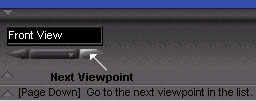
http://www-VRL.umich.edu/project/Florida/ Last Update: February 10, 2004, kpb
|
